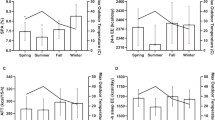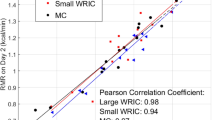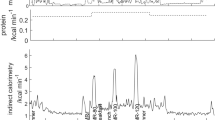Abstract
OBJECTIVE: During a stay in a respiratory chamber without an exercise protocol, physical activity is limited to activities of daily living, change of posture and ‘fidgeting,’ collectively referred to as spontaneous physical activity (SPA). SPA is quite variable among individuals and is a heritable trait. A low SPA during a chamber stay is a predictor of weight gain in men. However, it remains to be established whether physical activity in a respiratory chamber relates to physical activity under habitual, free-living conditions. The purpose of the present study was to determine whether physical activity in a chamber is correlated to habitual, free-living physical activity.
DESIGN: Fifty healthy, non-diabetic Pima Indians (30 M/20 F, 30±6 y; 37±10% body fat; means±s.d.) completed a 24 h stay in the respiratory chamber followed by a 7 day measurement of habitual, free-living energy expenditure by doubly labeled water. Free-living physical activity was expressed as activity energy expenditure (AEEFL; daily energy expenditure−(sleeping metabolic rate+thermic effect of food)), physical activity level (PALFL; daily energy expenditure/sleeping metabolic rate) and body-size independent activity units. Activity during the chamber stay was expressed as PALCh, AEECh, and based on radar sensor measurements, as percentage of time with activity (SPARadar).
RESULTS: AEEFL (averaging 930±310 kcal/day (3.89±1.30 MJ/day)) was correlated to AEECH (averaging 440±160 kcal/day (1.84±0.67 MJ/day)) and higher in men than in women (r=0.53, P=0.003) and r=0.53, P=0.02, respectively). Likewise, PALFL (averaging 1.75±0.21) was correlated to PALCh (averaging 1.42±0.10) and higher in men than in women (r=0.49, P=0.006 and r=0.42, P=0.02, respecitvely). Free-living activity expressed in body-size independent activity units (averaging 17.8±7.0) was correlated to SPARadar (averaging 6.4±1.7) with no effect of sex (r=0.30, P=0.03).
CONCLUSION: Physical activity in a respiratory chamber was correlated to habitual physical activity, whether expressed as AEE, PAL or body-size independent activity units, providing a plausible explanation for the demonstrated association between a low SPA in the chamber and weight gain. The study encourages further studies of the genetic and non-genetic determinants of SPA and non-exercise activity thermogenesis (NEAT).
This is a preview of subscription content, access via your institution
Access options
Subscribe to this journal
Receive 12 print issues and online access
$259.00 per year
only $21.58 per issue
Buy this article
- Purchase on Springer Link
- Instant access to full article PDF
Prices may be subject to local taxes which are calculated during checkout


Similar content being viewed by others
References
Must A, Spadano J, Coakley EH, Field AE, Colditz G, Dietz WH . The disease burden associated with overweight and obesity JAMA 1999 282: 1523–1529.
Ravussin E, Lillioja S, Knowler WC, Christin L, Freymond D, Abbott WG, Boyce V, Howard BV, Bogardus C . Reduced rate of energy expenditure as a risk factor for body-weight gain New Engl J Med 1988 318: 467–472.
Zurlo F, Lillioja S, Esposito-Del Puente A, Nyomba BL, Raz I, Saad MF, Swinburn BA, Knowler WC, Bogardus C, Ravussin E . Low ratio of fat to carbohydrate as predictor of weight gain: study of 24 h RQ Am J Physiol 1990 259: E650–E657.
Seidell JC, Muller DC, Sorkin JD, Andres R . Fasting respiratory exchange ratio and resting metabolic rate as predictors of weight gain: the Baltimore Longitudinal Study on Aging Int J Obes Relat Metab Disord 1992 16: 667–674.
Zurlo F, Ferraro RT, Fontvieille AM, Rising R, Bogardus C, Ravussin E . Spontaneous physical activity and obesity: cross-sectional and longitudinal studies in Pima Indians Am J Physiol 1992 263: E296–E300.
Rissanen AM, Heliovaara M, Knekt P, Reunanen A, Aromaa A . Determinants of weight gain and overweight in adult Finns Eur J Clin Nutr 1991 61: 419–430.
Prentice AM, Jebb SA . Obesity in Britain: gluttony or sloth? Br Med J 1995 311: 437–439.
Ching PL, Willett WC, Rimm EB, Colditz GA, Gortmaker SL, Stampfer MJ . Activity level and risk of overweight in male health professionals Am J Public Health 1996 86: 25–30.
World Health Organization . Diabetes mellitus Report of a WHO study group. WHO Technical Report Series 17: WHO: Geneva 1985 45–51.
Ravussin E, Lillioja S, Anderson TE, Christin L, Bogardus C . Determinants of 24-hour energy expenditure in man. Methods and results using a respiratory chamber J Clin Invest 1986 78: 1568–1578.
Abbott WGH, Howard BV, Christin L, Freymond D, Lillioja S, Boyce VL, Anderson TE, Bogardus C, Ravussin E . Short-term energy balance: relationship with protein, carbohydrate, and fat balances Am J Physiol 1988 255: E332–E337.
Ravussin E, Harper IT, Rising R, Bogardus C . Energy expenditure by doubly labeled water: validation in lean and obese subjects Am J Physiol 1991 261: E402–E409.
Coplen TB, Harper IT . An improved technique for the 2H/1H analysis of urines from diabetic volunteers Biol Mass Spectrom 1994 23: 437–439.
Ravussin E, Rising R . Daily energy expenditure in humans: measurements in a respiratory chamber and by doubly labeled water. In: Kinney JM, Tucker HN (eds). Energy metabolism: tissue determinants and cellular corollaries Raven Press: New York 1992
Schultz LO, Schoeller DA . A compilation of total daily energy expenditures and body weights in healthy adults Am J Clin Nutr 1994 60: 676–681.
Prentice AM, Goldberg GR, Murgatroyd PR, Cole TJ . Physical activity and obesity: problems in correcting expenditure for body size Int J Obes Relat Matab Disrod 1996 20: 688–691.
Chen KY, Townsend KM, Sun M, Buchowski MS . Association between laboratory and free-living physical activities in adult humans FASEB J 1999 13: A929 (abstract).
World Health Organization . Obesity—preventing and managing the global epidemic Report of a WHO Consultation on Obesity WHO: Geneva 1998
Allison DB, Paultre F, Goran MI, Poehlman ET, Heymsfield SB . Statistical considerations regarding the use of ratios to adjust data Int J Obes Relat Metab Disord 1995 19: 644–652.
Black AE, Coward WA, Cole TJ, Prentice AM . Human energy expenditure in affluent societies: a meta-analysis of 574 doubly-labelled water measurements Eur J Clin Nutr 1995 50: 72–92.
Levine JA, Eberhardt NL, Jensen MD . Role of nonexercise activity thermogenesis in resistance to fat gain in humans Science 1999 283: 212–214.
Goran MI, Poehlman ET . Endurance training does not enhance total energy expenditure in healthy elderly persons Am J Physiol 1992 263: E950–E957.
Kaprio JM, Koskenvuo M, Sarna S . Cigarette smoking, use of alcohol and leisure-time activity of same-sexed adult male twins. In: Gedda L, Parisi P, Nance WE (eds). Progress in clinical and biological research. Twin research 3: epidemiological and clinical studies Alan R Liss: New York 1991 37–46.
Perusse L, Tremblay A, Leblanc C, Bouchard C . Genetic and environmental influences on level of habitual physical activity and exercise participation Am J Epidemiol 1989 129: 1012–1022.
Acknowledgements
The authors are grateful to the members of the Gila River Indian Community, who have contributed enormously to the understanding of obesity and diabetes. The efforts of Tom Anderson (chamber measurements), Inge Harper (mass spectrometry), Lila Antone and Joann Pratt (recruiters) were greatly appreciated.
Author information
Authors and Affiliations
Corresponding author
Rights and permissions
About this article
Cite this article
Snitker, S., Tataranni, P. & Ravussin, E. Spontaneous physical activity in a respiratory chamber is correlated to habitual physical activity. Int J Obes 25, 1481–1486 (2001). https://doi.org/10.1038/sj.ijo.0801746
Received:
Revised:
Accepted:
Published:
Issue Date:
DOI: https://doi.org/10.1038/sj.ijo.0801746
Keywords
This article is cited by
-
Investigation of seasonality of human spontaneous physical activity and energy expenditure in respiratory chamber in Phoenix, Arizona
European Journal of Clinical Nutrition (2024)
-
Indirect calorimetry: an indispensable tool to understand and predict obesity
European Journal of Clinical Nutrition (2017)
-
Spontaneous Physical Activity Defends Against Obesity
Current Obesity Reports (2017)
-
Correlations of non-exercise activity thermogenesis to metabolic parameters in Japanese patients with type 2 diabetes
Diabetology & Metabolic Syndrome (2013)
-
Genetics of Physical Activity and Physical Inactivity in Humans
Behavior Genetics (2012)



